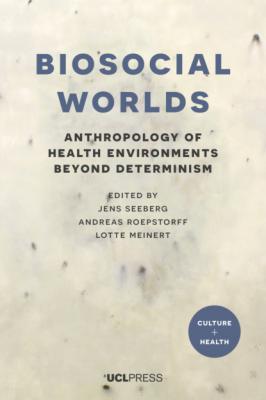Biosocial Worlds. Группа авторов
Читать онлайн.| Название | Biosocial Worlds |
|---|---|
| Автор произведения | Группа авторов |
| Жанр | Биология |
| Серия | |
| Издательство | Биология |
| Год выпуска | 0 |
| isbn | 9781787358263 |
Keller, E. F. 2014. ‘From gene action to reactive genomes’, Journal of Physiology 592 (11): 2423–9. https://doi.org/10.1113/jphysiol.2014.270991.
Kil’iljuss (Barb Wilson). 2009. ‘Strange new sickness’, Haida Laas; Journal of the Haida Nation (March): ii. http://www.haidanation.ca/wp-content/uploads/2017/03/jl_mar.09.pdf.
Kral, M. J. 2012. ‘Postcolonial suicide among Inuit in Arctic Canada’, Culture, Medicine, and Society 36: 306–25. https://doi.org/10.1007/s11013-012–9253-3.
Kugler, M. 2016. ‘The Minamata disaster and the disease that followed: Mercury poisoning that sickened an entire Japanese town’, Verywell: 1–3. Accessed 28 July 2020. https://www.verywell.com/minamata-disease-2860856.
Landecker, H. 2011. ‘Food as exposure: Nutritional epigenetics and the new metabolism’, BioSocieties 6 (2): 167–94. https://doi.org/10.1057/Biosoc.2011.1.
Landecker, H. and A. Panofsky. 2013. ‘From social structure to gene regulation, and back: A critical introduction to environmental epigenetics for sociology’, Annual Review of Sociology 39 (1): 333–57. https://doi.org/10.1146/annurev-soc-071312–145707.
Lappé, M. and H. Landecker. 2015. ‘How the genome got a lifespan’, New Genetics and Society 34: 152–76. https://doi.org/10.1080/14636778.2015.1034851.
Leblanc, D. 2014. ‘List of missing, killed Aboriginal women involves 1,200 cases’, The Globe and Mail, 1 May. Accessed 5 July 2020. https://www.theglobeandmail.com/news/national/rcmp-dont-deny-report-of-more-than-1000-murdered-missing-native-women/article18363451/.
Lewontin, R. 2000. The Triple Helix: Gene, organism and environment. Cambridge, MA: Harvard University Press.
Lewontin, R. 2001. It Ain’t Necessarily So: The dream of the human genome and other illusions. New York: New York Review of Books.
Lock, M. 2013a. ‘The lure of the epigenome’, The Lancet 381: 1896–7. https://doi.org/10.1016/S0140-6736(13)61149–6.
Lock, M. 2013b. ‘The epigenome and nature/nurture reunification: A challenge for anthropology’, Medical Anthropology 32 (4): 291–308. https://doi.org/10.1080/01459740.2012.746973.
Lock, M. 2015. ‘Comprehending the body in the era of the epigenome’, Current Anthropology 56 (2): 151–77. https://doi.org/10.1086/680350.
Markowitz, G. and D. Rosner. 2013. Lead Wars: The politics of science and the fate of America’s children. Berkeley: University of California Press.
Mattick, J. S. 2004. ‘The hidden genetic program of complex organisms’, Scientific American 291: 60–7. https://doi.org/10.1038/scientificamerican1004-60.
McGowan, P. O., A. Sasaki, A. C. D’Alessio, S. Dymov, B. B. Labonté, M. Szyf, G. Turecki and M. J. Meaney. 2009. ‘Epigenetic regulation of the glucocorticoid receptor in human brain associates with childhood abuse’, Nature Neuroscience 12 (3): 342–8. https://doi.org/10.1038/nn.2270.
Meaney, M. J. 2010. ‘Epigenetics and the biological definition of gene x environment interactions’, Child Development 81: 41–79. https://doi.org/10.1111/j.1467–8624.2009.01381.x.
Meaney, M. J., J. Diorio, D. Francis, J. Widdowson, P. LaPlante, C. Caldji, S. Sharma, J. R. Seckl and P. M. Plotsky. 1996. ‘Early environmental regulation of forebrain glucocorticoid receptor gene expression: Implications for adrenocortical responses to stress’, Developmental Neuroscience 18 (1–2): 49–60. https://doi.org/10.1159/000111395.
Meloni, M. 2014. ‘How biology became social, and what it means for social theory’, Sociological Review 62 (3): 593–614. https://doi.org/10.1111/1467-954X.12151.
Monk, C., J. Spicer and F. A. Champagne. 2012. ‘Linking prenatal maternal adversity to developmental outcomes in infants: The role of epigenetic pathways’, Development and Psychopathology 24: 1361–76. https://doi.org/10.1017/S0954579412000764.
Mosa, A. and J. Duffin. 2016. ‘The interwoven history of mercury poisoning in Ontario and Japan’, Canadian Medical Association Journal 189 (5): 213–15. https://doi.org/10.1503/cmaj.160943.
Naumova, O. Y., M. Lee, R. Koposov, M. Szyf, M. Dozier and E. L. Grigorenko. 2012. ‘Differential patterns of whole-genome DNA methylation in institutionalized children and children raised by their biological parents’, Development and Psychopathology 24: 143–55. https://doi.org/10.1017/S0954579411000605.
Niewöhner, J. 2011. ‘Epigenetics: Embedded bodies and the molecularisation of biography and milieu’, BioSocieties 6 (3): 279–98. https://doi.org/10.1057/biosoc.2011.4.
Niezen, R. 2013. Truth and Indignation: Canada’s Truth and Reconciliation Commission on Indian residential schools. Toronto: University of Toronto Press.
Nelson, C. A., N. A. Fox and C. H. Zeanah. 2013. Romania’s Abandoned Children: Deprivation, brain development and the struggle for recovery. Cambridge, MA: Harvard University Press.
Oxford English dictionary. 2020. Accessed 4 August 2020. https://www.oed.com/view/Entry/63089;jsessionid=B58807B83D42EE50AB224D3E290CE480?redirectedFrom=environment#eid.
Radiological Society of North America. 2009. ‘Childhood lead exposure causes permanent brain damage, ScienceDaily, 2 December. Accessed 5 July 2020. https://www.oed.com/view/Entry/63089;jsessionid=B58807B83D42EE50AB224D3E290CE480?redirectedFrom=environment#eid.
Ramirez-Goicoechea, E. 2013. ‘Life-in-the-making: Epigenesis, biocultural environments and human becomings’. In Biosocial Becomings: Integrating social and biological anthropology, edited by T. Ingold and G. Palsson, 59–83. Cambridge: Cambridge University Press.
Relton, C. and G. Davey Smith. 2012. ‘Is epidemiology ready for epigenetics?’, International Journal of Epidemiology 41: 5–9. https://doi.org/10.1093/ije/dys006.
Richardson, S. S. 2015. ‘Maternal bodies in the postgenomic order: Gender and the explanatory landscape of epigenetics’. In Postgenomics: Perspective on biology after the genome, edited by S. S. Richardson and H. Stevens, 210–31. Durham, NC: Duke University Press.
Roberts, E. 2016. ‘Gods, germs, and petri dishes: Toward a nonsecular medical anthropology’, Medical Anthropology 35 (3): 209–19. https://doi.org/10.1080/01459740.2015.1118100.
